The Dorian mode is the next scale on your to-do list.
Another scale? Well, if you’re reading this, you’ve already recognized the power of scales for learning music much more quickly, as well as writing and improvising your own. You’ve strived with and vanquished at least a few major and minor scales. And you may know that there is a whole world of scales beyond major and minor.
In today’s music, the Dorian mode is the next most popular and useful seven-note scale.
So let’s add the Dorian mode to your toolbox! In this lesson, we’ll learn:
- The music theory behind the Dorian mode
- How the Dorian scale compares with other scales, particularly the C major scale
- How to play the Dorian mode in every key
- How to practice and master the Dorian mode
- When and how to play the Dorian scale on your instrument
- How to listen for the Dorian mode
But first, a little lesson about modes in general:
What’s a Mode?
The modes are seven note scales derived from the major scales. We’ll take the C major scale as a starting point:
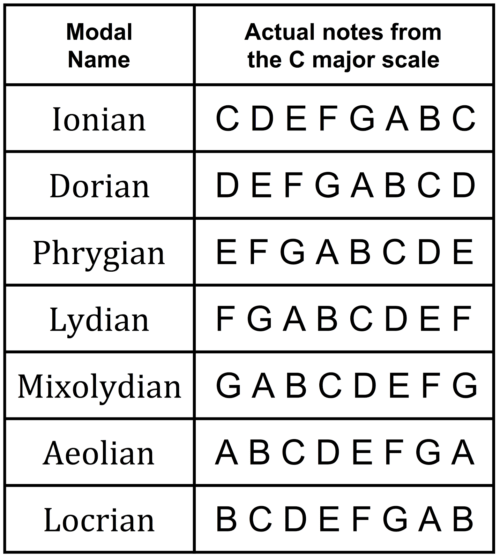
Though these names may sound bizarre to the uninitiated, the principle is actually quite simple. By shifting the tonic to a different scale degree in the major scale (starting with C major, for example), you create a whole new seven note sequence with a whole new feel – without technically changing a single note!
All the modes above return to their starting note to make an octave.
The coolest thing about modes is that you already know them! Once you know a major scale, you merely have to take the same notes, start and finish on a different scale step and you’ve gone totally modal!
Try playing through each one of the modes in this chart. Experience the different mood of each mode.
The C major scale is the same thing as an Ionian scale beginning on C. In fact, the Ionian scale of any key is simply the major scale of that key.
So the Dorian mode of C major begins and ends on D. The Dorian sehas a whole and half step pattern of whole-half-whole-whole-whole-half-whole in an octave:
If you want to dive in deeper into what makes the Dorian scale Dorian, Basic Music Theory lays out all the mechanics of the Mode.
Why Learn Modes?
Modes open up a new way of listening to and writing music. Each seven note mode has a unique sequence of whole steps and half steps, and therefore each has a musical role that it was destined to play. For example, while the classic Ionian scale’s upbeat and bright feel lends itself well to pop music, Lydian has more unusual intervals that makes it very suitable for jazz music. Similarly, though they are both technically minor modes, the Dorian scale is known for its melancholy-yet-hopeful tone (it’s technically a minor mode!), distinguishing it from its more ambiguous, tension-filled cousin, Phrygian mode.
The usefulness of using modes in songwriting cannot be overstated. By experimenting with the unique mood that different modes can give you, you can craft your songs to have maximum impact, matching the style of the song to a mode that will really bring out its energy.
Dan Haerle provides a quick rundown of how you can put the modes to work in jazz improvisation.
How do I learn all these modes?
The coolest thing about modes is that you already know them, and they’re all closely related! Once you know a major scale, you merely have to take the same notes, start and finish on a different scale step and you’ve gone totally modal!
You can then easily transpose the same system from the C major chart above into any major scale you like.
Yes, these modes are already under your fingers. The real work is learning, and identifying what they sound like. For now, let’s focus in on the second mode of the major scale, the extremely useful, popular – and the whole reason you are here today – Dorian mode!
Learning the Dorian Mode
So far, we’ve learned that a mode is derived by taking the notes of a scale and changing which note in the scale is used as the root note (tonic).
So, the Dorian scale is simply the mode that begins on D, and uses the same notes as C major (with no sharps or flats) and is played D-E-F-G-A-B-C-D. Here is the D Dorian on a keyboard diagram and a fretboard diagram:
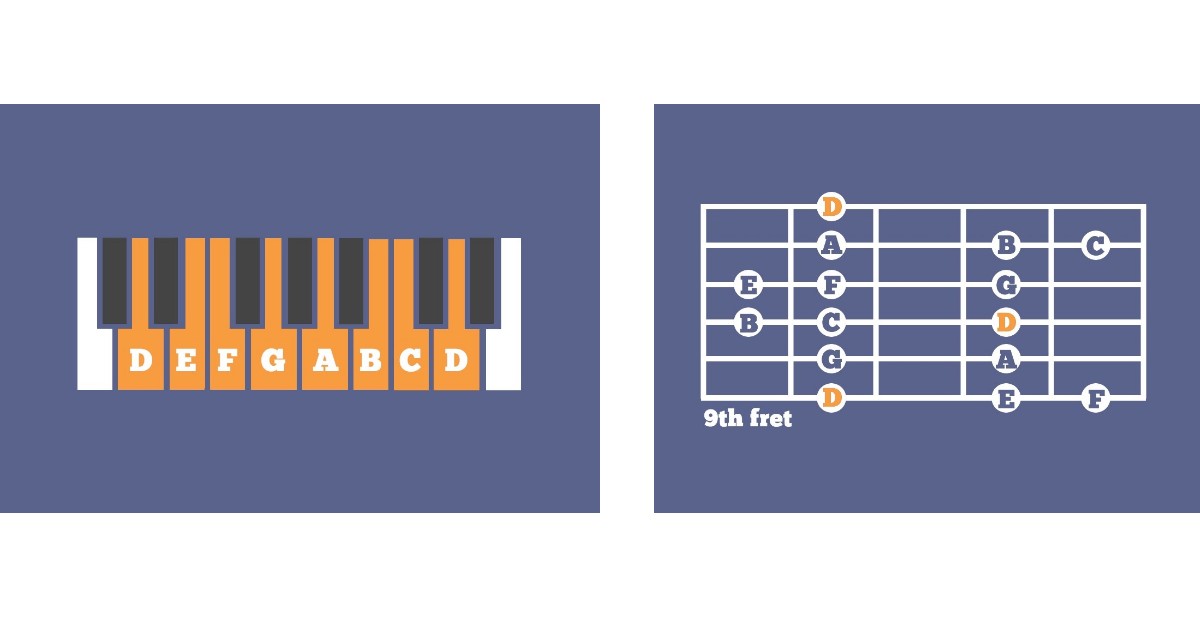
You’ll notice it follows a certain pattern of tones and semitones (whole steps and half steps), which is the “fingerprint” of the Dorian scale:

Transposing the Dorian Mode
Here are two ways to figure out the Dorian scale starting on any note:
1. Use the template
Using the tone and semitone sequence discussed above, you can easily transpose the Dorian mode into any key you desire. Start with the root note, and fill in the rest of the notes using the pattern.
Try this exercise: construct Dorian mode starting on F#.
Show answer

2. Derive from the major scale
As we said earlier, if you know your major scales, you already know your Dorian mode. Depending on your instrument and the way you think, major scales may well be the easiest way to figure out the Dorian mode.
Let’s say you want to figure out B Dorian. Look down a whole step (tone) to A. The B Dorian scale will then have the same key signature (three sharps in this case) as the A major.
Try this method with D♯ Dorian:
Comparing Dorian to the Natural Minor Scale
The Dorian scale and the natural minor scale (known as Aeolian in modal parlance) are both considered minor modes. In major scales, the interval between the root and the third note is a major third (a distance of four semitones). In minor scales, the interval between the root and the third note of the scale is a minor third (three semitones).
→Learn more about major and minor scales
Let’s compare these two scales:
Immediately, you’ll notice the major 6th interval in the A Dorian – that major 6th is formed between the A and the F♯, creating a different whole step and half step sequence than the Aeolian mode. Listen to the example below comparing the minor scale and the Dorian mode. Try to listen for the “bright” spot on the sixth note of the scale, where the sixth degree is raised:
Both modes contain a minor third between the first and third degree, giving them their “minor” quality. However, the appearance of the major sixth in the Dorian scale goes a long way in distinguishing it from the sad, wistful Aeolian mode. Since this major sixth creates a “bright spot” in the mode, Dorian mode takes on a more intense, driving feel.
Comparing Dorian to the Major Scale
We saw above that Dorian mode in D can be derived from the C major scale ( aka the ionian mode) simply by starting on D instead of C, and using all the same notes. Though the D Dorian scale and the C major scale indeed use the same notes, and in the same order, they have completely different moods.
Why?
When the starting note changes, so does the tonal center. This, in turn, changes the tone/semitone pattern, which affects the intervals found in the mode. The result? The D Dorian scale and the C Ionian (C major) scale have completely different feels, even though they are technically using the same notes in a given key.
Try improvising with natural notes (white keys on the piano) over a D, then over a C – hear the difference? How does the improvisation with natural notes sound different?
The minor third found between the first degree and third degree of the Dorian mode lends it a minor quality as opposed to the C major scale. In Ionian mode, this interval is a major third, making the mode major as well.
Yet that major sixth in the Dorian mode, which is also found in the major scale, “brightens” the Dorian’s sound in comparison to the usual minor scale.
From Major to Dorian
Though the two modes are radically different in sound, ionian can help you find your way to the correct notes of Dorian. We’ve already studied how to derive the Dorian scale on the second degree of the major scale, but what if you want a quick way to figure out the Dorian scale that starts on the same root as a major scale?
To write Dorian mode in a given key, take the third and seventh degrees of the corresponding major scale in that key, and lower them.
Try this: use the A♭ major scale to write out the Dorian mode in A♭.
Show answer

Dorian Mode Songs
Now that you know the basic theory behind it, let’s see how the Dorian scale is actually used.
Dorian is a versatile mode that can work with both major and minor keys. Though it’s a minor mode, its major sixth gives an unexpected drive and brightness to the scale. Dorian also works well with the pentatonic scale, and the two can be overlapped and alternated for incredible impact.
Because of its melancholic-yet-somehow-upbeat mood, the Dorian scale is most often spotted in its natural habitat: jazz and blues music. However, it’s certainly not limited to these genres, and is often featured in pop, rock, and metal music to add interest.
Looking for some songs in the Dorian mode? Let’s start with Santana:
Here’s a head start on your Dorian playlist:
- Wicked Game – Chris Isaak
- Oye Como Va – Santana
- Evil Ways – Santana
- So What – Miles Davis
- Purple Haze – Jimi Hendrix
- Eleanor Rigby – The Beatles
- Scarborough Fair – Simon & Garfunkel
- Impressions – John Coltrane
And of course, these are just the famous ones.
Practicing in the Dorian Mode
Start off with learning the mode inside-out, making sure you’re getting all the notes right. Get comfortable playing the scale both ascending and descending, ensuring that you’re able to play it in any key.
As with anything, start small and simple, really taking the time to understand the theory behind the Dorian scale before diving in.
1. Play Scales
Start by playing the Dorian mode, ascending and descending, in D. As you begin to recognize the tone and semitone pattern and commit it to memory, experiment with transposing this scale into other keys.
Eventually, you’ll be able to comfortably play the Dorian scale in any key.
2. Practice Intervals and Scale Interval Patterns
Once you get comfortable playing scales, try practicing intervals. The Dorian mode consists of a minor third, perfect fourth, perfect fifth, major sixth, and a minor seventh. Play these intervals and experiment with which kind of mood each gives within the mode.
Then, go ahead and play the Dorian scale in interval patterns. For example, try playing the ascending scale in fifths:
Once you get comfortable enough with scale patterns to have an idea of what sounds good, start expanding your repertoire and playing more freeform melodic note patterns, keeping in mind your tonal center.
3. Experiment with “Dorian” Chords/Triads
Try playing clusters of notes together that are built on Dorian mode. Use the flattened third and seventh degrees to create minor triads and minor seventh chords, and incorporate chords with the sixth degree to add interest!
Here are some of these chords on a fretboard diagram, to get you started:
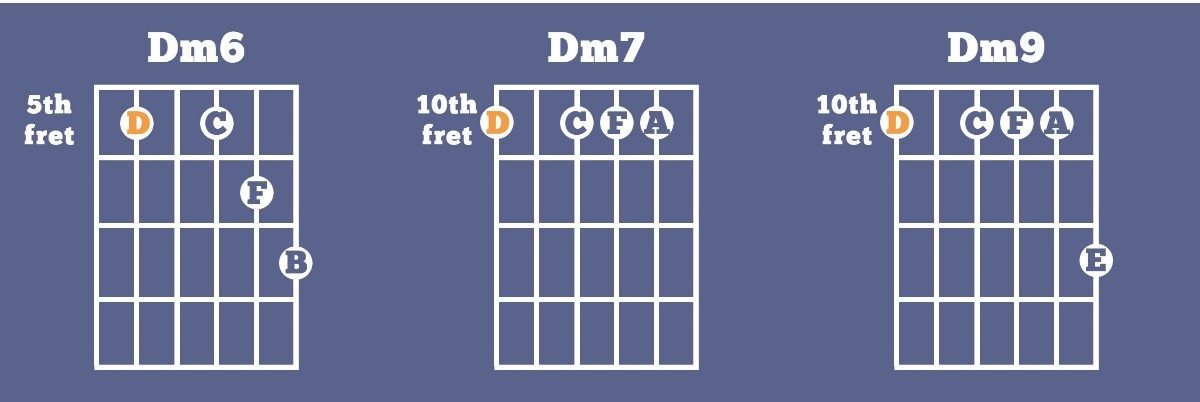
And on a keyboard diagram:
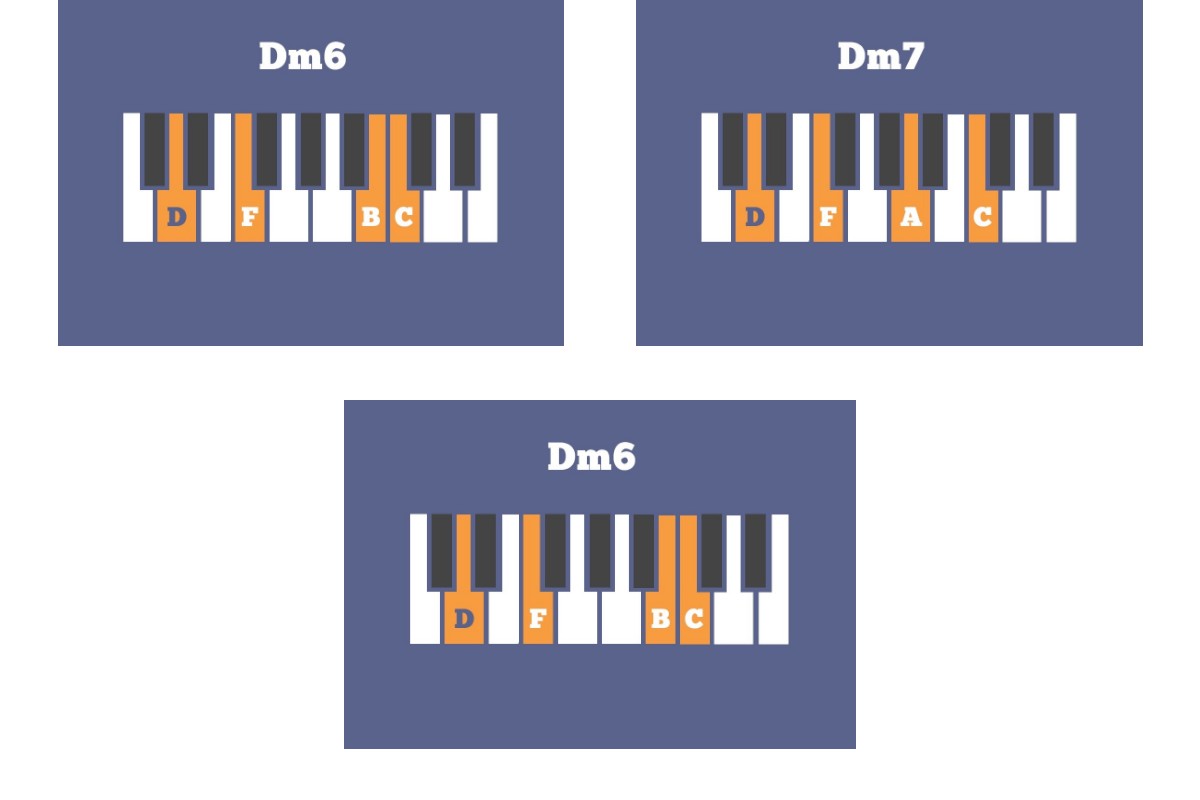
Piano Dog shares a concise breakdown of cool Dorian chord progressions.
4. Put it all together!
Using the following backing track, try improvising in the D Dorian mode. Focus on the characteristic intervals of the mode, play around with minor chords, and exploit that distinctive major sixth sound to create an improvised tune in Dorian mode over the following backing track:
For Extra Practice…
Another excellent exercise is to transcribe solos from songs you like that are written in Dorian. Once you have the notes written out on paper, look for the kind of patterns that the song has used, and take note of how the features of Dorian mode are used for impact.
Dorian and Your Instrument:
In music, the Dorian mode can be used differently depending on the instrument and the style it’s being played on. Let’s see how this mode can be used for maximum effect on your instrument.
Dorian Guitar
In many genres, the Dorian mode may even be more common than the natural minor scale, particularly for guitarists. There are plenty of songs, such as “Eleanor Rigby” by the Beatles or “Scarborough Faire,” that use it. You can find more examples of Dorian Mode in popular music here:
Most jazz guitarists use it significantly – but then jazz guitarists are typically expected to know and use every major scale mode!
The Dorian mode commonly stands in for the minor pentatonic scale (rather than the natural minor scale). The minor pentatonic scale is very common in rock, hard rock, and metal music – the Dorian scale lightens the mood and increased the drive in all those genres. This makes Dorian mode quite practical – if a chord progression can be solo-ed over with the minor pentatonic scale, chances are, the Dorian scale will also sound great over that chord progression.
The Dorian mode allows guitarists to use the minor pentatonic riffs, but add in the major sixth note to get a brighter feel. This particular mode is common in glam rock and hair metal, since both are guitar driven genres. George Lynch, in particular, is well known for using this mode:
The examples below are nearly identical guitar riffs. The first riff consists of some basic pentatonic scale guitar work in a minor scale. The second riff is the same line with the major sixth added in a few places to brighten up the line:
If the guitar does have a rhythm line in Dorian, it will usually be a single note line. The following example demonstrates a possible Dorian line for guitar:
Dorian Bass
Generally speaking, the major sixth is not used as part of the chord progression in Dorian songs. The chord progressions typically found in minor pentatonic songs – the I, IV, and V chords – are more common.
It is more common for the Dorian scale to be used by the bass as part of the rhythm section. The examples below contain the same guitar rhythm, but the second example uses a Dorian line underneath it:
Dorian Piano
Did you know that the Dorian mode can make a perfect Father’s Day gift? One really enjoyable way to dig into the Dorian sound is to play a D – A – D drone with your left hand, and improvise on the white keys with your right hand:

Then you can transpose to other keys.
Pianoscales lines out the Dorian mode in every key, including keyboard diagrams.
And PianoLessons.com makes it easy in this video:
The Dorian mode is the most common minor scale in piano jazz. It can be used alone, or interspersed with other scales, as in this tutorial:
Dorian Violin, Flute, Saxophone, Voice, etc.
For melody instruments and voice, the Dorian mode is very common in jazz. Taming the Saxophone gives a thorough breakdown of Dorian mode jazz and funk, along with free downloads of backing tracks, and Trumpetland has a great beginner’s guide to trumpet improvisation including discussion of modes.
Dorian scales are also pervasive in many types of folk music. Listen to this driving Irish Dorian tune:
Listening for the Dorian
Hopefully, the examples above have started to tune your ear into the sound of the Dorian mode. Follow up on some of the example artists and recordings mentioned to continue to build your familiarity with the Dorian sound. You should start to hear that major sixth pop out at you!
The Dorian mode can be tough to hear in some situations. After all, it is only one note off from the Aeolian mode (natural minor) and the Mixolydian mode. Any rock or metal song that seems slightly too “upbeat” is usually a good candidate to be in Dorian. Usually, the best place to focus is going to be the bass or the solo if you are unsure if it is the Dorian scale or the minor pentatonic.
Remember, the major sixth note is the key to recognizing a song is in the Dorian Mode. If it is present, but the rest of the scale sounds overall minor, then it is almost always the Dorian mode. Listen back to the audio tracks above to really internalize the Dorian sound.
As you practice transcribing songs, try to look out for this major sixth in a minor musical context to identify songs using the Dorian Mode. As you find more and more examples of it in use, your ear will get more and more reliable at recognising it straight off.
So there you have it: an introduction to the world of Dorian. We’ve taken you through a whirlwind of theory, playing exercises, and instrumental applications of this intense, moody, and driving mode. Now, it’s your turn: grab your instrument, and jam out your own Dorian masterpiece!
This article is based on one originally written by Matthew Abdallah

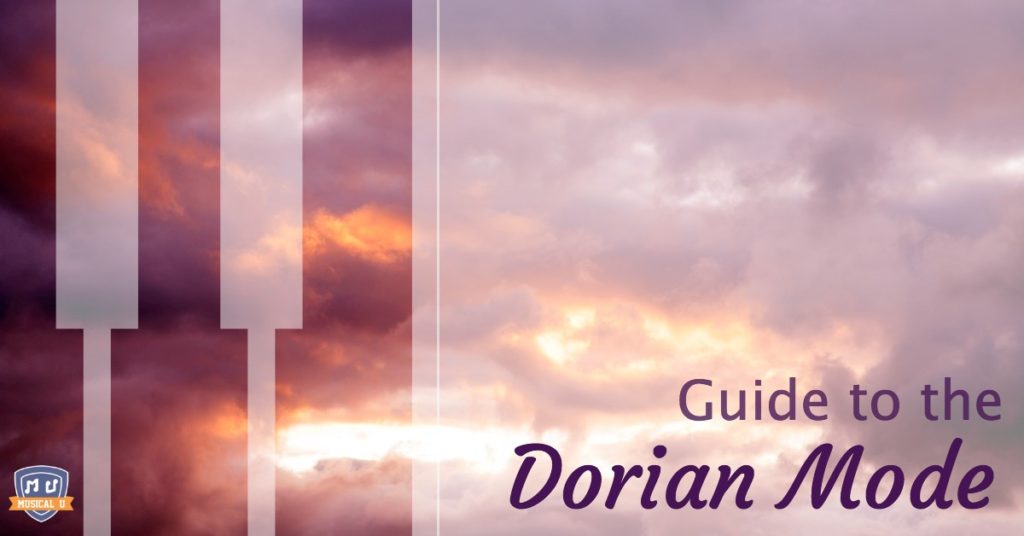










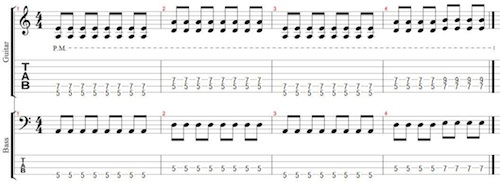
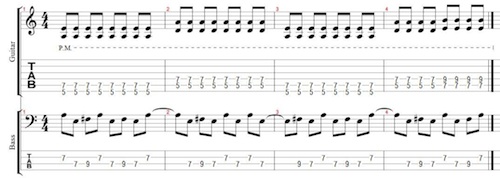






Well done!
But may I suggest that the easiest way to recognize and use the modes is to relate them to the key they belong to.
Your example of the A dorian mode should simply have an F# in the keysignature which then means it is the scale used over the A minor chord being the second step of the key of G.
Learning the 7 modes in every key plus a solid knowledge of the cycle of 4ths/5ths (depending which direction you follow it) is a great foundation.
Gb – Db – Ab – Eb – Bb – F – C – G – D – A – E – B – (F#)
Great ear training tools are all over the net. I reviewed many of them to save you finding them.
Go here: http://www.eartraining.whitecirclemusic.com
Keep up the good work, George B
In the Dorian bass line example, the chords (open fifths, actually) being A5 D5 A5 D5 E5 are technically ambiguous as to whether they are major or minor, but, in practice, strongly suggest the A-Major scale to me. The bass line uses the notes A, E, and F#. Those three notes occur in the A-major scale, and the A-Dorian, A-Lydian, and A-Mixolydian modes. What I fail to understand is, what is it about the bass part that makes it Dorian?
The text states that it's the presence of the major 6th (F# in the bass line example) plus an overall minor feel that makes it Dorian. I would need to hear a C (a minor third from A) for it to have a minor feel. None occurs.
The Dorian guitar part has the same problem. We are clearly dealing with E as the tonic. D, C#, and B also occur. These notes occur in E-Dorian as well as E-Mixolydian. What makes it Dorian? C#, the major 6th, is there but there is no G to give it a minor feel.